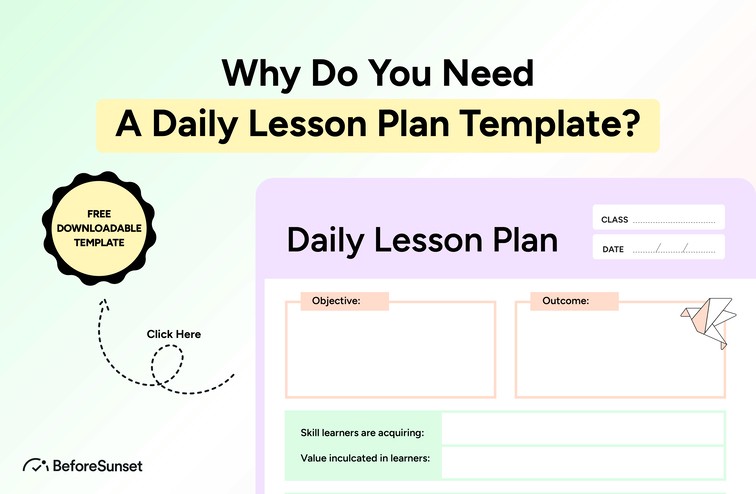A daily lesson plan template is an essential tool for teachers since it gives the teaching process organization and efficiency. It acts as a thorough road map, directing teachers through each lesson with specific goals, teaching techniques, and evaluation systems.
This structure makes ensuring that key elements of a class, such as learning objectives, and resources, are methodically handled. It also aids educators in maintaining a standard framework for their lesson plans, making it simpler for teachers and students to follow and understand.
Effective lesson plan templates also make it simple to share and modify them, encouraging collaboration among teachers.

What is a Daily Lesson Plan Template?
Teachers and educators can organize and manage their daily teaching activities using an editable lesson plan template, which is a useful resource. It acts as a well-organized framework outlining the aims, material, instructional techniques, and evaluation procedures for each distinct class or lesson within a wider curriculum.
These templates are created to simplify the preparation process, making it simpler for teachers to present engaging and well-organized lessons that are in line with academic standards and learning objectives.
A Simple Lesson Plan Template improves teaching efficiency, promotes deliberate pedagogy, and ultimately results in more fruitful student learning experiences by giving a clear blueprint for what has to be completed in each session.
Benefits of Using A Daily Lesson Plan Template
Teachers and educators may prepare and deliver excellent courses with the help of lesson planning, which has a number of advantages. Some of the main benefits are as follows:
Organization: Templates offer an organized style for class planning, ensuring that instructors take into account all crucial elements, from objectives to evaluation techniques. This group assists educators in staying on task and avoiding missing crucial details.
Efficiency: By removing the need to construct engaging lesson plans from scratch for each class, templates save time. Planning becomes more effective when educators may reuse and modify templates for various lessons or future use.
Clarity: Templates aid teachers in making their educational objectives and plans clear. Teachers have a clear idea of what they want to accomplish in each class by articulating objectives and material, which improves communication with students.
Curriculum Alignment: School lesson plan templates may be created to be in line with educational objectives and curriculum standards, ensuring that lessons are logical and congruent with more general learning goals.
Consistency: Templates encourage uniformity in instructional strategies. Students find it simpler to follow and anticipate the framework of each class when teachers adopt a template format for all of their classes.
Flexibility: Although templates offer structure, they also give you room for change. To fit the particular requirements of their pupils or to include new instructional methods or resources, educators might alter and change templates.
Assessment Integration: Educators can more easily prepare how they will assess students' comprehension and development by using templates that contain sections for assessment approaches. This guarantees that the assessment reflects the goals of the course.
Resource Planning: Templates ask teachers to make a list of the supplies and equipment required for each lesson, ensuring that all materials are ready in advance and minimizing disruptions in the classroom.
Professional Development: By allowing educators to share templates, they may collaborate and advance their careers. Teachers may share weekly lesson plan templates and get knowledge and inspiration from one another.
Documentation: Templates act as a record of what was taught and how it was taught, providing documentation. They may be useful for reflection, evaluation, and the recording of instructional strategies.
Legal and Administrative Compliance: A daily lesson plan format may be necessary in some educational contexts in order to comply with administrative or regulatory rules. A standardized template can be used to satisfy these needs.
Student Engagement: By including clear objectives and activities that capture students' attention and participation, a well-structured lesson plan may promote student engagement.
Effective Communication: To manage expectations and communication, templates can be provided to students or parents to give a clear outline of what will be addressed in class.

Types of Daily Lesson Plans
Teachers and educators build their daily lesson plans in a variety of ways depending on the requirements of their students and the subject matter they are teaching. Here are a few typical formats for daily lesson plans:
Standard Lesson Plan: The most typical kind of daily lesson plan format is the standard lesson plan. It has parts like goals, resources, an overview, the primary idea, actions, evaluation, and a conclusion. It uses a predetermined framework to direct the educational process.
Detailed Lesson Plan: A detailed lesson plan layout takes things a step further by giving a thorough breakdown of each teaching strategy. It contains thorough descriptions of each activity's procedures, and scheduling guidelines for each section of the class, and frequently includes particular questions or engagement-inspiring prompts for the students.
Activity-Based Lesson Plan: Activity-based lesson activity plans put an emphasis on practical or interactive learning opportunities. They place a strong emphasis on learning through projects, experiments, group projects, and activities. The activities are specifically described in the plan, along with how they relate to the learning goals.
Lesson Plan for a Flipped Classroom: In a flipped classroom approach, students participate in learning activities outside of class (such as reading or viewing videos) and then use class time for active learning and discussion. Pre-class and in-class activities, such as debates and problem-solving, are outlined in the monthly lesson plan.
Inquiry-Based Lesson Plan: Inquiry-based teacher planners enable students to ponder issues, look into specifics, and find solutions via supervised investigation. Critical thinking and problem-solving abilities are emphasized in these programs. The inquiry method and the teacher's guiding role are described in the lesson plan.
Cooperative Learning Lesson Plan: Cooperative learning lesson plans are types of lesson plans that puts a strong emphasis on group projects and student cooperation. They lay out the duties, roles, and obligations of the group, encouraging cooperation and the growth of social abilities.
Differentiated Instruction Lesson Plan: Differentiated instruction lesson designs allow students of various learning styles and aptitudes to coexist in the same classroom. The lesson plan incorporates tactics, such as differentiating materials, assessments, or activities, to adapt instruction to fit the requirements of each individual student.
Technology-Enhanced Lesson Plans: These types of lesson plans use technological teaching aids and learning materials. They describe how technology, such as particular applications, programs, or gadgets, will be used to improve the lesson. Resources such as ABCmouse provide a trove of subject-focused games for kids that can be incorporated into these technology-enhanced lesson plans, seamlessly blending learning and fun.
Culturally Responsive Lesson Plan: Culturally responsive lesson type take into account and appreciate the various cultural backgrounds of their pupils. They strive to make instruction and content inclusive and culturally appropriate.
Literacy or Reading Lesson Plan: The development of reading, writing, and language skills is the main emphasis of these literacy or reading lesson plan ideas, which are created for language arts or literacy programs. They could contain particular techniques for enhancing reading comprehension and writing abilities.
Lesson Plans for Math or Science: Designed for math and science classrooms, these lesson plans place an emphasis on experimentation, problem-solving, and critical thinking. They frequently contain certain mathematical or scientific terms and techniques.
Physical Education Lesson Plans: Physical education lesson plans describe physical activity, skill-building games, and exercises. They could also have goals for developing one's motor skills and safety concerns.
Art or Music Lesson Plan: Lesson Plans for Visual Arts, Music, and Other Artistic Expressions: These plans are created for creative arts classes and contain activities, projects, and methods connected to these art forms.
Lesson Plans for Special Education: Special education lesson plans are tailored to the specific requirements of kids with disabilities. Modifications, accommodation, and unique aims could be among them.
English as a Second Language (ESL) or English Language Learner (ELL) Lesson Plans: These plans are designed to aid non-native English speakers in learning the language. They put an emphasis on vocabulary, linguistic ability, and cultural blending.
How to Use a Daily Lesson Plan Template Effectively
Effective use of a daily lesson plan template requires a number of important measures. Start by outlining your learning objectives in detail and relating them to academic criteria. After that, arrange your template by sequentially filling in the areas for objectives, materials, teaching techniques, and evaluations.
Adapt your material to the interests and different learning preferences of your pupils, and make sure the exercises are rationally sequenced. While teaching, adhere carefully to the plan while remaining adaptable to make changes as needed in response to student feedback and development.
Consider what went well and what needs to be improved after the class to enhance your teaching methods in the future.
Use your templates as essential planning and assessment tools to improve the effectiveness and efficiency of your instruction by regularly updating and customizing them to meet changing curricular requirements and student demands.

Using Google Docs for Your Daily Lesson Plan Templates
Utilizing technology to make instructional duties more efficient has become crucial for educators in the digital era of education. One such priceless resource is Google Docs, which provides an easy-to-use platform for maintaining your Daily Lesson Plan Templates.
There are several benefits to moving away from conventional paper-based lesson plans and toward digital ones, including accessibility from any device, real-time collaboration with colleagues, and simple modifications.
Advantages of Using Google Docs for Daily Lesson Plans
For educators, using Google Docs to create daily lesson plans has numerous compelling benefits. First of all, it makes plans accessible from any device with an internet connection, enabling instructors to work on them inside and outside of the classroom.
Real-time collaboration tools make it simple for coworkers to share and amend lesson ideas, encouraging cooperation and idea sharing. Lesson plans are kept up-to-date and flexible to changing demands thanks to Google Docs' simple modifications and version control features.
Your lesson ideas are also safely backed up and conveniently accessible thanks to its cloud-based storage. Overall, Google Docs improves productivity, accessibility, and cooperation in the lesson preparation process, making it a priceless tool for educators looking to organize their regular teaching tasks.
Step-by-Step Guide to Creating and Sharing Your Daily Lesson Plans with Google Docs
It's simple to create and distribute daily lesson plans using Google Docs. Open Google Docs and start by making a new document. For quick reference, include the date and lesson topic in the title. Then, add sections for objectives, supplies, activities, and assessments to your lesson outline. For organizing, use headings or bullet points.
To improve clarity and engagement, add hyperlinks, photos, or other multimedia components. Click the "Share" button when your lesson plan is prepared to work with others. You may issue them an invitation and let them know if they can only see, give feedback, or update the document.
Feedback may be given, changes can be made in real-time, and anybody with access to the document can do so. Your work is automatically saved by Google Docs, ensuring that it is always current and available whenever you need it.
Tips for Optimizing Your Google Docs Daily Lesson Plans
Take these suggestions into account while creating your Google Docs daily lesson plans. To improve readability, format the text clearly and consistently throughout, using headers, bullet points, and typefaces.
Create a table of topics for your lesson plans to make navigating simple. Utilize the real-time collaboration and sharing tools in Google Docs to share your plans with coworkers and receive input and comments. To access internet resources or extra content, use hyperlinks.
To keep your lesson plans effective and current, update and alter them frequently. Finally, use Google's cloud-based storage to keep your lesson plans safe and available from any device with an internet connection.

Learning Objectives and Instructional Strategies in the Classroom
Learning Objectives and Instructional Strategies are two important components that are at the forefront of efficient teaching and learning in the ever-changing educational landscape. These elements determine the direction of each classroom trip and serve as the guiding lights in a teacher's toolset.
Setting the framework for a learning experience that is driven by purpose, learning objectives outline the precise information, skills, and results that students are expected to achieve.
While using a variety of tactics, resources, and approaches to engage and empower students, educators enable this journey through the use of instructional practices.
Understanding Learning Objectives
When describing what students should know, understand, or be able to perform as a result of a learning experience, learning objectives—also known as instructional objectives or learning outcomes—are explicit and detailed.
These goals serve as the culmination of teaching and learning, offering teachers a road map for developing and evaluating their lesson plans. Cognitive (knowledge-based), affective (emotional and attitudinal), and psychomotor (skills and physical abilities) learning objectives are often divided into these three areas.
They are essential to education because they provide clear standards for both instructors and students, direct the choice of subject matter and teaching strategies, and serve as the foundation for assessments that gauge how well students are learning.
Effective curriculum development, instruction, and evaluation are essentially created on the basis of learning objectives, which ensure that education is meaningful, quantifiable, and in line with intended results.
Identifying Instructional Strategies That Work Best For Your Classroom
Identifying instructional strategies that work best for your classroom involves a thoughtful and dynamic process. It begins with a deep understanding of your students' needs, learning styles, and interests. Tailor your strategies to match these factors, aligning them with your specific learning objectives and curriculum standards.
Experiment with a variety of methods, such as lectures, discussions, group work, hands-on activities, technology integration, or project-based learning, and assess their effectiveness through feedback and student performance data.
Flexibility is key; be ready to adapt and refine your strategies based on ongoing assessment and student engagement. Collaborate with fellow educators to share insights and discover new approaches.
Ultimately, the most effective instructional strategies are those that foster a positive and inclusive learning environment, inspire student curiosity and participation, and consistently drive toward achieving your educational goals.

Different Week, Month, Grade Level, And Single Lessons Planning Formats
The length, grade level, and general focus of the lesson can all affect the lesson preparation forms. Educators often map out a week's worth of lessons, identifying daily goals, exercises, and assessments.
By preparing courses for a complete month and sometimes adding overarching themes or sections, monthly planning broadens the viewpoint. By matching material and teaching strategies to age-appropriate learning objectives, grade-level planning formats respond to the particular demands of each grade level.
A single class session is the emphasis of a single lesson, which has specific objectives, activities, and assessments. Whether for short-term objectives or long-term curricular goals, each of these forms is an essential tool for teachers to successfully arrange their instruction. The range of teaching and the preferences of the teacher influence the format selection.
Download Our Free Daily Lesson Plan Template
BeforeSunset AI brings you the best free daily lesson plan template. You can download it for free!


